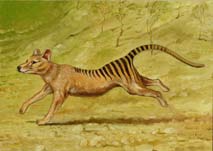
November 5, 2010

Bill Warren of Fallbrook says he bought what might be the pelt of an extinct Tasmanian tiger at a garage sale a few months ago for $5. An auction house is in negotiations to secure the skin so it can be sold. Photo by Charlie Neuman.
Compare with a zebra duiker (Cephalophus zebra) – and what its pelt would look like.


In an article by Carl Ciaramella, in the San Diego Union, a remarkable story is unfolding about the finding of a valuable hide of a supposedly extinct animal in the USA.

Thylacines at Hobart Zoo in 1910 (Photo: Wikipedia).
“It pays to go to garage sales sometimes,” Fallbrook resident Bill Warren said.
He should know. Warren might turn a $5 buy into $70,000 after finding what appears to be the pelt of an extinct Tasmanian tiger at a garage sale.
Warren found the unusual looking animal skin in Rainbow in June. The owner had bought the skin some 30 years ago at another garage sale in Boston.
“I didn’t know what it was, and neither did she,” Warren said. But he had a hunch it was something interesting.
They settled on $5 and a handwritten receipt of sale.
It was only after a couple weeks of Internet sleuthing that Warren began to get an idea of just how interesting the pelt might be.
The Tasmanian tiger was a dog-like marsupial carnivore native to the island of Tasmania. Due to hunting and loss of habitat, the tiger was declared extinct in 1936, when the last known animal died in captivity. Since then, there have been no confirmed sightings.
Most of the known skins reside in museums and universities. All of which makes a pelt extremely valuable for private collectors.
“They’re a very rare item to come across,” said Andrew Snooks from Armitage Auctions in Australia.
Snooks said the auction house is negotiating with Warren to obtain the pelt. After the house confirms that the pelt is indeed a Tasmanian tiger, it will go up on the auction block.
Snooks said the last Tasmanian tiger pelt sold at the auction house went for $68,000, and a rug made from eight pelts sold for $260,000.
Of course, there is still the business of verifying the pelt. Warren sent photos of the animal skin to John Long, vice president of research and collections at the Natural History Museum of Los Angeles. Long responded by e-mail that it looked like a Tasmanian tiger, but only expensive testing could confirm it.
Before Warren can cash in, though, there are other complications. He can’t sell the pelt over state lines because it’s still listed on the endangered species list by the U.S. Fish and Wildlife service. Even if it is an oversight, it will take precious time to petition the department to remove the animal from the list.
“It’s like putting a Brontosaurus on the endangered species list,” Warren said. “It’s driving me nuts.”
For now, Warren is applying for an exemption and hoping for the best.
If the story sounds fantastical, it is but one more in a long string for Warren, who is something of a character and tireless self-promoter.
For example, Warren plans on using money from the sale to fund his treasure-hunting outfit, Golden Quest Co., which searches for shipwrecks around the world.
He’s also a singer who put out four albums (he’s on YouTube) and says he knew Sinatra. And he sued the United States over ownership of the small island of Navassa in the Caribbean. (He planned on harvesting the island’s rich supply of bird guano.)
He also ran for Congress twice.
“I’m an entrepreneur if there ever was one,” Warren said.
About Loren Coleman
Loren Coleman is one of the world’s leading cryptozoologists, some say “the” leading living cryptozoologist. Certainly, he is acknowledged as the current living American researcher and writer who has most popularized cryptozoology in the late 20th and early 21st centuries.
Starting his fieldwork and investigations in 1960, after traveling and trekking extensively in pursuit of cryptozoological mysteries, Coleman began writing to share his experiences in 1969. An honorary member of Ivan T. Sanderson’s Society for the Investigation of the Unexplained in the 1970s, Coleman has been bestowed with similar honorary memberships of the North Idaho College Cryptozoology Club in 1983, and in subsequent years, that of the British Columbia Scientific Cryptozoology Club, CryptoSafari International, and other international organizations. He was also a Life Member and Benefactor of the International Society of Cryptozoology (now-defunct).
Loren Coleman’s daily blog, as a member of the Cryptomundo Team, served as an ongoing avenue of communication for the ever-growing body of cryptozoo news from 2005 through 2013. He returned as an infrequent contributor beginning Halloween week of 2015.
Coleman is the founder in 2003, and current director of the International Cryptozoology Museum in Portland, Maine.
Filed under Breaking News, CryptoZoo News, Cryptozoology, Extinct, Thylacine